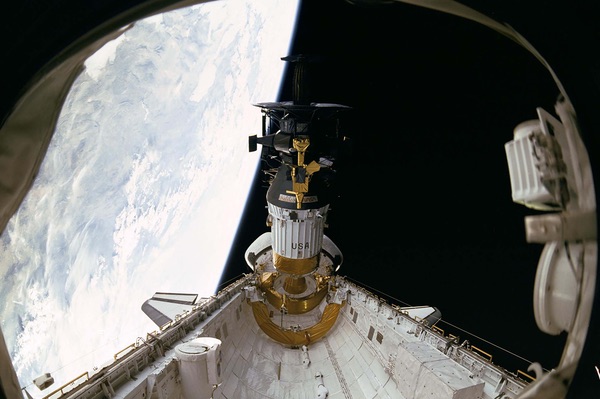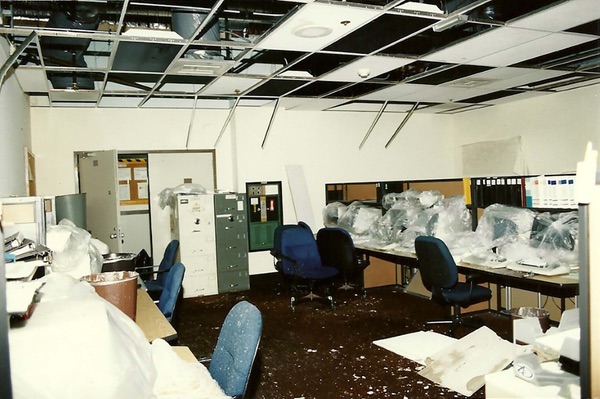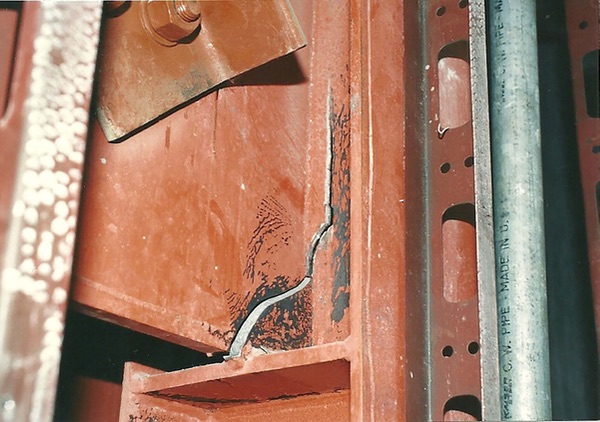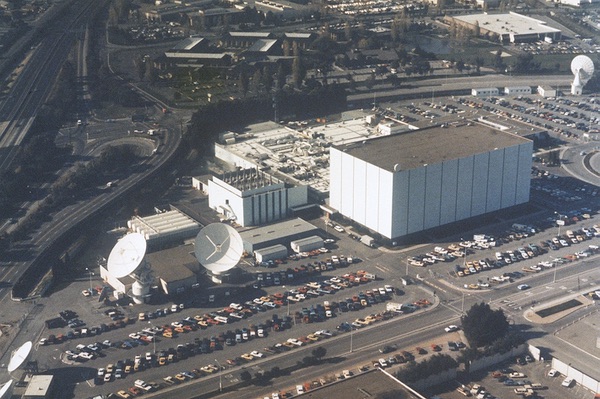Rock-solid (Blue) Cube: Galileo and the 1989 Loma Prieta earthquakeby Joseph T. Page II
|
 The Galileo space probe sits atop its IUS booster inside of Atlantis’ cargo bay on October 18, 1989. (credit: NASA) |
Making planetary science cool again
In the months preceding the launch of Galileo, NASA had a banner year in planetary exploration. In May, Atlantis launched Magellan on a mission to map the surface of Venus using synthetic aperture radar. On August 25, Voyager 2—NASA’s interplanetary grand dame—passed through the Neptunian system during its last planetary encounter in the solar system. The launch of Galileo was highly anticipated because of its primary mission focus of Jupiter and its Galilean moons. Originally conceived of as the “Jupiter Orbiter Probe” in the early 1970s, the project officially began in summer 1977, just weeks before the Voyagers lifted off for the outer planets. The loss of the Challenger in 1986 saw exploratory space missions requiring a shuttle launch pushed back to near the end of the decade. When NASA finally selected Galileo’s launch window, the space agency had successfully transitioned the shuttle program from the post-Challenger shock into a successful return to flight. The accident cleared the shuttle program’s manifest of commercial satellite launches and gave Galileo, the first deep space mission designed exclusively to launch from the shuttle’s cargo bay, a definitive launch date of October 17, 1989. Cloud cover in Florida bumped the launch to the following day. [2]
Blue Cube support to NASA
On the days leading up to Atlantis’ launch, personnel of the then-named Consolidated Space Test Center (CSTC) at Onizuka Air Force Base ran operations for classified National Reconnaissance Program constellations while they readied shuttle support for NASA. As the nexus of the Air Force Satellite Control Network (AFSCN), the Sunnyvale-based crews provided flight planning and resource scheduling for the orbiter, as well as tracking, telemetry & commanding (TT&C) for the IUS booster. [1]
| In typical Air Force fashion, the panels were painted light blue, leading to the nickname the “Blue Cube.” |
Originally built for the command and control of National Reconnaissance Program satellites, the facility received an upgrade to support the Manned Orbiting Laboratory (MOL) program (see “To look out from a higher plateau: the naming of Onizuka Air Force Station,” The Space Review, February 8, 2016). Building 1003, colloquially known as the “Blue Cube,” would establish its legacy by operating satellite constellations for the Air Force, Navy, National Reconnaissance Office (NRO), and supporting every space shuttle launch for NASA.
For earthquake damage mitigation, Building 1003’s exterior included pre-fabricated concrete panels three inches (7.5 centimeters) thick, designed to break away during an earthquake. In typical Air Force fashion, the panels were painted light blue, leading to the nickname the “Blue Cube.”
The Loma Prieta earthquake
During the early evening of October 17, many denizens of the Bay Area were preparing to watch the third game of the 1989 World Series. The championship was the first cross-town World Series since 1956, pitting the San Francisco Giants against the Oakland Athletics. The Giants were hosting the A’s at Candlestick Park on the San Francisco side of the bay. The game was schedule to start at 5:35 pm local time, but news broadcasters began their pre-game shows at 5 pm. Four minutes after the hour, a magnitude 7.1 earthquake emanated from a location 16 kilometers northeast of Santa Cruz. Army Staff Sergeant David Langdon was at Candlestick for the opening ceremonies:
“The spooky part of [the earthquake] was looking up in the stands, completely full. Imagine Candlestick Park completely coming apart and going back together. To see the slabs above the upper deck separate by feet and come back together, and watch the light stanchions sway left and right from the apex to the center, about fifteen feet either way, it was a sight to behold, if you've never seen it. Then to look out to the field and just see it roll as if it were an ocean, because it was moving like a wave, just like water.” [3]
The shaking lasted approximately 15 to 20 seconds and was captured live by newscasters awaiting the start of the game. When the quake subsided, the destructive tally included 63 people dead, 3,757 injured, and approximately $6 billion in damages across the Bay Area.
 Offices inside the Consolidated Space Test Center show damage after a magnitude 7.1 earth quake on October 17, 1989. (courtesy of Onizuka Alumni) |
Built to last… maybe?
After the Loma Prieta earthquake struck, Building 1003’s unique panels seemed to have done their job. Inside of the CSTC buildings, though, was a different story. The quake tossed around desks, chairs, and classified material safes while throwing plenum-ceiling panels to the floor. Tape libraries shelves, containing critical command and control data for numerous space missions, lay tipped over in many of the mission control centers. The scariest evidence of damage from the earthquake was unveiled weeks after the quake: the metal girders comprising the building’s internal skeleton showed noticeable cracks.
 Inspectors found a half-inch wide crack is on this structural support beam inside of the Blue Cube. Many cracks like this were uncovered weeks after the earthquake. (courtesy of Onizuka Alumni) |
While rescue crews were pulling victims and casualties from collapsed buildings and freeways around San Francisco Bay, CSTC leadership decided to allow workers back inside the building to continue support. The official Galileo history report from NASA recounts:
| However, judging from the photographs inside the CSTC, the decision to re-enter the facilities only hours after the quake—with the ever-present danger of aftershocks—to get the mission done was courageous by any definition. |
“As the Galileo team prepared for the next day’s launch, a magnitude 7.1 earthquake struck northern California, just miles south of the Inertial Upper Stage (IUS) control center, which was crucial to mission operations. The crew had to evacuate, and it looked like the mission would have to be pushed back once more. But the crew was able to return later in the night and go back online.”
The NASA history does not downplay the earthquake and its impact on the people or the mission. However, judging from the photographs inside the CSTC, the decision to re-enter the facilities only hours after the quake—with the ever-present danger of aftershocks—to get the mission done was courageous by any definition.
Aftermath
The Loma Prieta earthquake forced the US government to move more space operations away from the Bay Area. The Air Force built the Consolidated Space Operations Center (CSOC) in Colorado Springs in the mid-1980s to control military shuttle missions. With the creation of CSOC for Air Force operational space missions, the facilities at Onizuka continued their mission of development and test, while still flying NRP missions until its closure in 2010. While the Loma Prieta earthquake remains a footnote in US space history, this story is a testament to the men and women of Onizuka who pushed through the danger and got Galileo on its way to Jupiter.
References
- Cleary, Mark C. The Cape: Miltary Space Operations 1971-1992. Patrick AFB, FL: 45th Space Wing Office of History.
- Meltzer, Michael. Mission to Jupiter: A History of the Galileo Project. Washington, D.C.: NASA History Division.
- Iversen, Eve. An Oral History of the Presidio of San Francisco During the Loma Prieta Earthquake. University of California at Davis.
Note: we are temporarily moderating all comments submitted to deal with a surge in spam.
